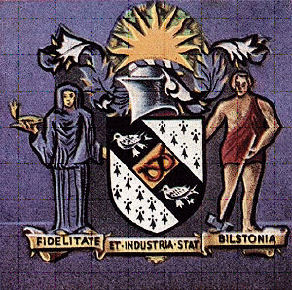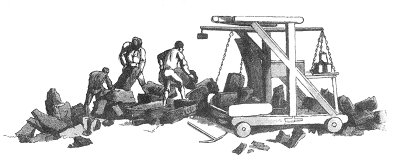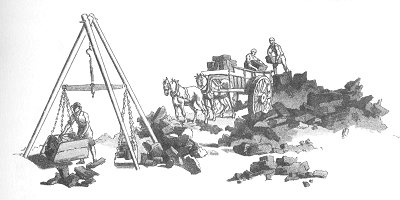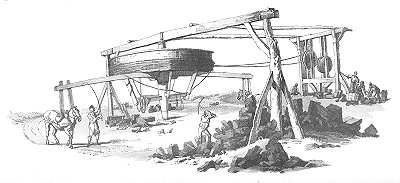 |
A History of Bilston4. The Development of Mining |
|
Lawley's picture is of an agricultural village but even in earlier days coal was being obtained for domestic use. In a church register a curate of Bilston in the seventeenth century said :- "I have been told that coal hath been got in Bilston as far back as 1380, and also that one Humphrey Mattocks was killed in 1392, while working in a cole pitt". Even in 1315 a gift of land had been made to "Johanna de Wedbesbyrie of a piece of land lying in Braddeley, over against ye cole pitts." In a deed of 24th May 1401, made by William Perrye de Bylstone to John, his son, mention is made of "a piece of land with ye two cole pitts thereon situate called ye Hollowaye and ye Delves, situate near Windmille Field, in Bilston". In another grant, made by John Peppard to William Robyns, of Bilston in 1418, mention is made of "One competent carriage of lande coales, to be drawn by five horses from ye cole pits in ye Upper Horwall, situate neare to Ettingshall ".
Leland, the antiquary, who wrote in the reign of Edward VI, tells us "That sea coles abounde nere to Wolverhampton and Wesbyrie" and Camden, in his Britannica, says: "The south part of Staffordshire hath coles digged out of the earth, and mines of iron, but whether to their commodity or hindrence I leave to the inhabitants who do and shall better understand it ."

Breaking up newly mined coal. An early 19th century drawing but very similar to the earliest mines of this area
One mine in particular was started in 1490 by three Bilston men who sunk their first shaft, it being square in shape, supported on the sides by scantling timber. The coal was raised by a common windlass. This mine continued for many years, when it passed into the hands on John Tomkyns, in which family it continued until purchased by Mr. Pursehouse, in 1640, whose son, Mr. Joseph Pursehouse gave Dr.Plott the following account of this mine:
"In South Staffordshire there are twelve or fourteen collieries at work, and twice as many out of work within ten miles around, some of which afford 2,000 tons of coal yearly, others 3,000 and even 5,000 tons. The upper beds, above the ironstones, lie sometimes ten, eleven and twelve yards thick; nay, I was told by Mr. Pursehouse that in his grounds at Ettingshall, at a place called Moorfields, the bed of coal is fourteen yards thick, in as much that some acres of the ground have been sold for £100 an acre. I was informed of one which sold for £150 and well indeed it might be so, for out of a single shaft there has been sometimes drawn £500 worth of coal".

Owing to the primitive methods used in mining at this time was impossible to secure adequate drainage or guard against caving in when the coal was removed.
The Church registers of the locality afford many instances of Colliery fatalities:
1689 My charges for ye funerall of ye collier att Wrixam's 12s 4d
1725 Wednesday. Richard Allons was buried by me ( Mr Ames) at four-o-clock this afternoon. He was killed in a cole pit near the Portway Road
1735 Nov.25. Buried. Thomas Teese, a collier, killed by a fall of coals in Wolverhampton cole pit
1756 Buried. Jane Rowley. She was landing coals at ye pit-eye, and ye board on which she stood broke. N.B. Ye landing board stands over ye pit-eye, so that on the breaking of this board she fell to the bottom of ye pitt, and was so much bruised that she died soon after.1758 Oct.23. Buried. John Blewer. He was going down into a colepitt and ye work belonging to Mr Gibbons, of Etttingshall, and ye rope broke, by wh accident he fell to ye bottom of ye pitt and was killed.1766 John Jones (buried April 15). He was killed in a coalpitt by a fall of coals.
In this district pack-horses were trained to carry a large box or basket on either side, each large enough to hold about two hundredweight. Long strings of these animals, as well as of donkeys and mules, were to be seen slowly wending their way over the wretched ways from the collieries to the towns. Sometimes the drivers had to plunge into deep holes up to the knees.

The collieries of South Staffordshire supplied the whole of the adjacent counties, and files of horses laden with coals were to be met with as far away as Coventry, Stourbridge, Wellington and Macclesfield. When long journeys like these were undertaken the expense was reduced by putting one driver in charge of several horses, and providing relays at given distances.
The cost of coal thus conveyed was, of course, considerably increased, doubled in fact, but the scarcity of wood, and the dearness of charcoal, had made coal a necessity. From the time of Plott, mining operations gradually increased until Bilston grew famous both for the quality of its coal and the superiority of its ironstone.
The following statement of the produce of the mines in Bilston in the year 1827, is taken from The Parish Amendments Book
| Name | tons p.a. | Name | tons p.a. |
| Joseph Hickman | 2,600 | R Cross | 3,120 |
| Joseph Maybury | 3,120 | E Woolley | 3,820 |
| T B Price | 1,560 | B Bickley | 6,240 |
| Job Hartshorn | 3,120 | Stanford & Co | 6,240 |
| Mrs Walker | 34,320 | Mo Fryer | 3,120 |
| Wlliam Ward | 21,200 | Mr Loxdale | 20,280 |
| Messrs Sparrow | 31,200 | Exors of Wilkinson | 2,600 |
| J.F.Ferriday | 28,600 | J Addenbrook | 6,240 |
| P Wlliams | 10,400 | Scott & Foley | 62,400 |
| Mr Bagnall | 7,800 | Messrs Breretons | 7,800 |
| Mr Robyns | 9,360 | W Smith | 6,240 |
| Adam Hill | 3,120 | T Banks | 29,720 |
| William Riley | 2,600 | Total | 316,746 |
click here to go on to Bilston in Transition: 1790
click here to return to the Bilston History Contents
Page